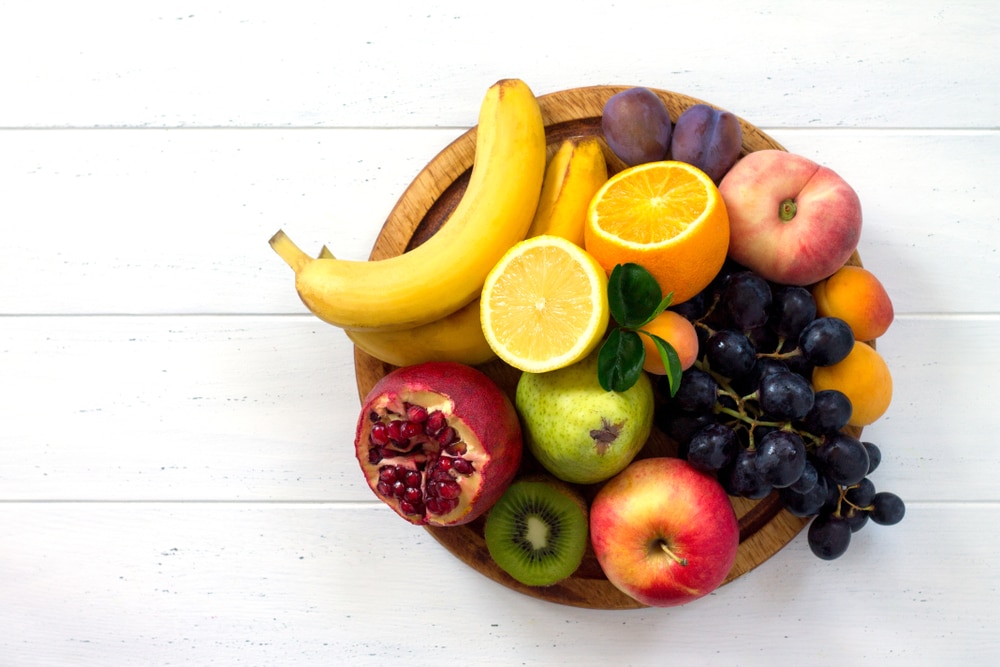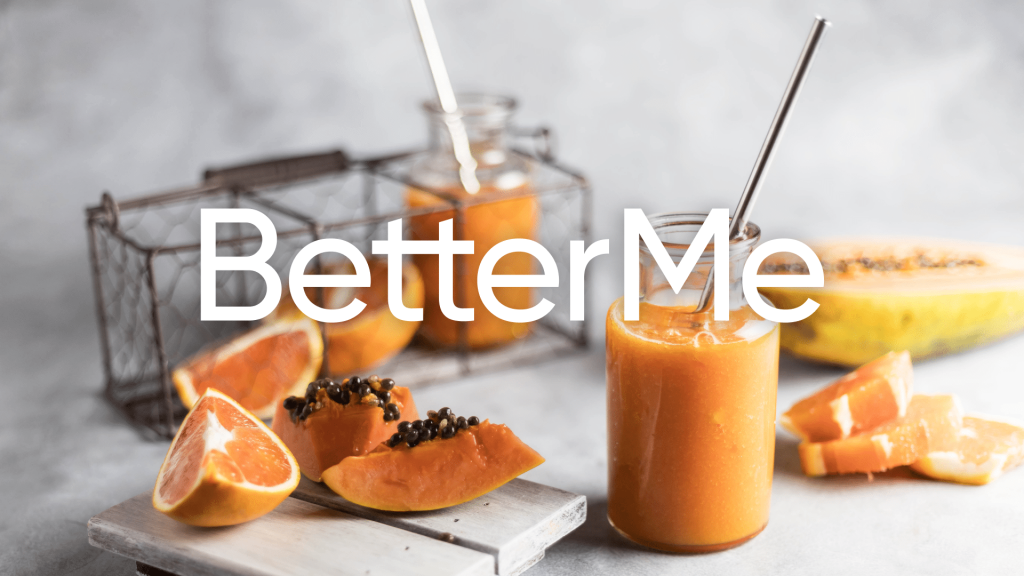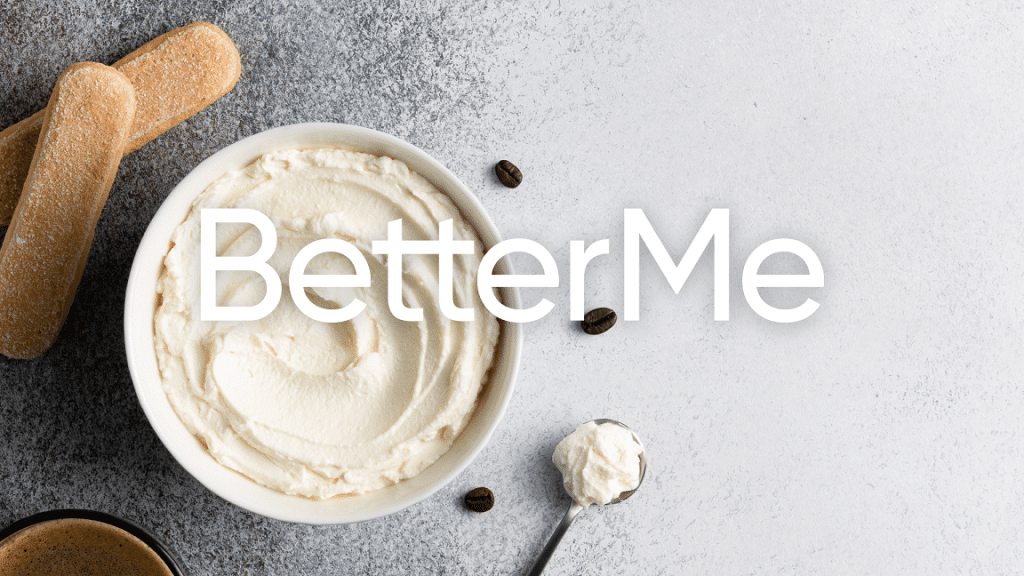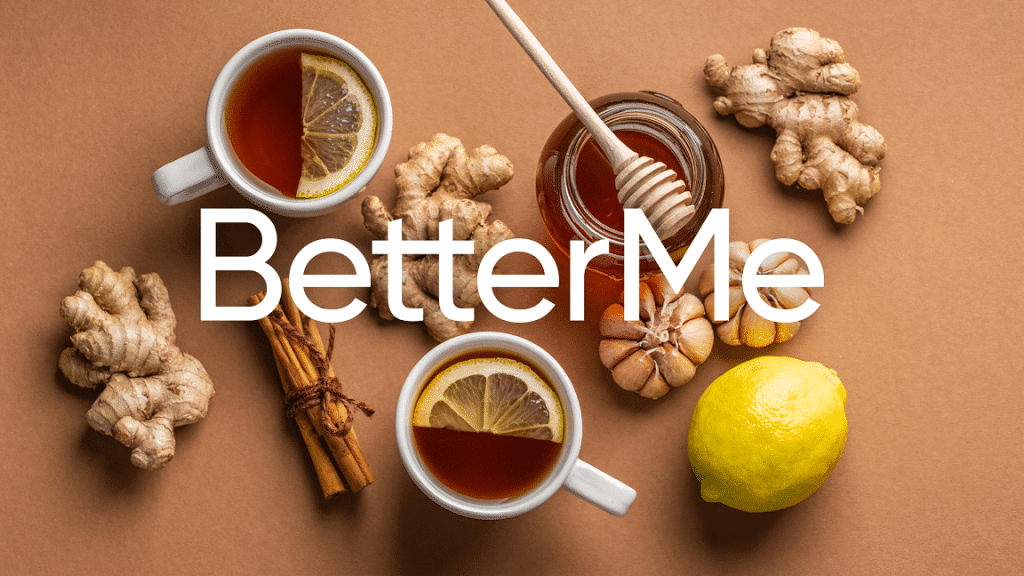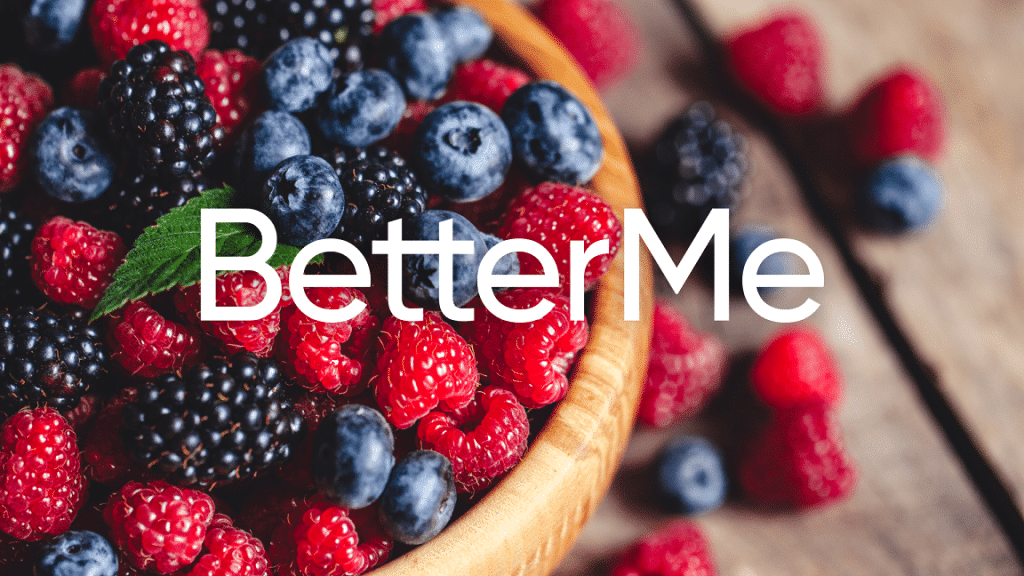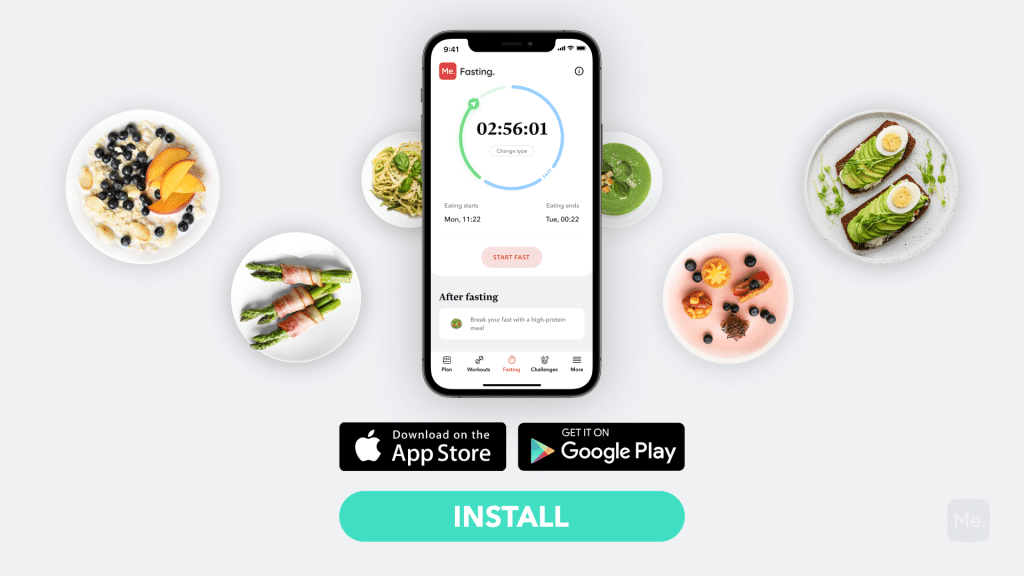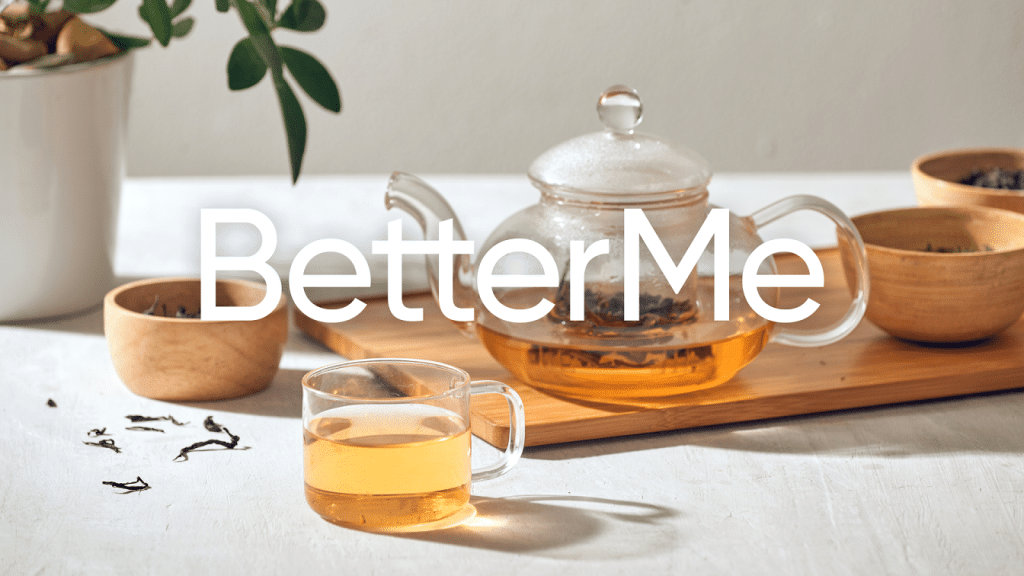Fructose is natural fruit sugar and when it comes from fruit is assumed to be one of the “good” sources of sugar in our diets. For most people fructose isn’t a problem unless their intake of processed foods high in refined sugar (including fructose) is excessive. Rarely, some people are unable to digest or absorb fructose and are considered to be fructose intolerant. They need to limit or avoid fructose as much as possible.
Get your personalized
meal plan!

Furthermore, people with insulin resistance and those trying to lose weight might also need to watch their intake of this sugar (10). If you are one of those people, this article will help you out by giving you a list of foods with fructose.
What Is Fructose?
Fructose is a simple sugar that exists in fruit (as its name implies). Simple sugars include glucose (found in blood and muscle cells) and fructose. Glucose is the main energy source for the body, while fructose mainly provides energy to the liver.
Fructose behaves differently than other types of sugars when consumed. It does not stimulate insulin secretion and is handled by the liver as a sugar, unlike other sugars that are broken down into glucose before entering the bloodstream.
There are two sources of fructose: high-fructose corn syrup (HFCS) and fruits.
Read More: Fructose Vs. Sucrose: Which Is The Healthier Option?
High-Fructose Corn Syrup
HFCS is an artificial sweetener that consists of two simple sugars, fructose and glucose, but in slightly different ratios than natural fructose. Fructose makes up 42% to 55% of HFCS, and the rest is glucose (15).
The common ratio is 55% fructose and 45% glucose. HFCS has been used for many years as a sweetener in soft drinks, fruit drinks, cereals, baked goods (especially in combination with high-glucose corn syrup), condiments, and jams/jellies.
Fructose In Fruit
Some fruits contain more than 50% of fructose; this includes dates, raisins, grapes (and grape juice), apples (and apple juice), and pears (and pear juice). Fruits that have less than 25% fructose content include bananas, cantaloupes, honeydew melons, and strawberries (9).
Is Fructose Bad For You?
Like most sugars, fructose comes with several negative effects worth noting.
Can Increase Your Risk Of Being Overweight
Some companies are starting to use HFCS instead of sucrose (table sugar) as much as possible. Sucrose consists of 50% fructose and 50% glucose (slightly different from HFCS).
The reason is that it provides more sweetness than sucrose or glucose alone, which can be more cost effective for the manufacturer.
However, studies have shown that drinking soft drinks sweetened with high-fructose corn syrup increase your risk of being overweight or obese because fructose alters how your body breaks down fats and carbohydrates.
Furthermore, foods with fructose hardly ever make people feel full. Therefore, they can trigger greater food intake, which results in weight gain (11).
Can Cause Insulin Resistance
A 2016 study looked at the effects of fructose-rich drink consumption in those aged 12–16 years in Taiwan. People who drank more fructose-rich drinks had higher levels of insulin resistance, which is a marker for hardened arteries, diabetes, and heart disease in adults (12).
Whether you’re a workout beast or just a beginner making your first foray into the world of fitness and dieting – BetterMe has a lot to offer to both newbies and experts! Install the app and experience the versatility first-hand!
May Increase Triglyceride Levels
Triglycerides are fats found in the blood that can lead to cardiovascular diseases and heart attacks if they become too high. High triglycerides are also thought to be a risk factor for developing diabetes, although other studies have shown this effect is not very significant.
When compared directly with glucose, fructose consumption tends to have more of an effect on blood lipids (like triglycerides) while glucose has more of an effect on insulin and blood sugar levels. In real life, however, fructose and glucose are typically eaten together in roughly equal amounts, and so both contribute to weight gain and have different but concurrent metabolic effects (6).
May Increase Uric Acid Concentrations
Uric acid is a waste product created when the body breaks down substances called purines (the main ingredient in DNA, as well as some plant and animal foods). High uric acid levels can occur when there are more breakdown products than normal in the body.
The cause for this increase is still unknown, but it may be related to eating fructose-rich foods. One study examining the metabolism of fructose shows that fructose stimulates the production of uric acid. However, scientific evidence shows that high purine intake only increases blood uric acid levels slightly (20).
Fructose-Rich Foods May Be Hard To Digest
When large amounts of fructose are consumed in a short period, it can cause gastrointestinal disturbances such as nausea and diarrhea. Some people may also experience abdominal bloating and cramping when fructose overloads their intestines, so they should limit how much fruit they eat or drink at one time (14). This is much more likely to happen from drinking juice or other high-fructose beverages than from eating whole fruit.
Fruit Juices Can Contain More Fructose Than Soft Drinks
Contrary to popular belief, consuming natural juices from fresh fruit is not healthier for you than drinking soda pop if both contain equal amounts of sugar (including fructose) and calories.
Studies show that although fresh fruit juices contain vitamins and minerals, they still raise blood sugar levels just as fast as soft drinks containing HFCS do (9).
This is because the body breaks down fructose in a similar manner to how it absorbs glucose, which is straight into your bloodstream. Fresh fruit juices also contain more than 10% fructose, whereas commercial sodas only have up to 10 grams per 12oz can (9).
Who Needs To Limit Fructose Intake?
Most people can take moderate amounts of fructose without experiencing negative side effects. However, the following groups of people should avoid this sugar:
People With Fructose Intolerance
Fructose intolerance is a rare genetic disorder, which prevents fructose from being absorbed by the body and metabolized. It is treatable with a diet low in fructose-containing foods (14).
People With Insulin Resistance
When you consume excess fructose, your liver converts it to fat. This type of fat deposit can cause or worsen metabolic disturbances such as insulin resistance. Insulin resistance may eventually lead to Type 2 diabetes because your cells become less sensitive; moreover, it may also develop leptin resistance, leading to increased appetite and possibly weight gain (14).
Read More: Is Sucralose Bad For You? Facts About This Artificial Sweetener
People Who Want To Lose Weight
People who want to lose weight should avoid all of the above-listed foods, especially those who have insulin resistance or are pre-diabetic. The same is true if you also have hypothyroidism or chronic fatigue syndrome (14).
Stay away from foods that contain high fructose corn syrup on labels since they are most commonly found in processed beverages, bread, cereals, and baked goods like sweet rolls and desserts, as well as condiments, such as barbecue sauce and ketchup.
What Foods Do You Have To Avoid With Fructose Intolerance?
Fruits
It should be noted that naturally occurring fructose in fruits is not the problem here. Fruits are beneficial to health, being an excellent source of fiber, vitamins, and antioxidants.
You’re advised to eat whole fruits rather than fruit juice. Because whole fruits have fiber and offer more chewing resistance, which means you’re less likely to overeat them. Juice, on the other hand, is easy to drink and you might take in too much fructose.
Below are the fructose quantities of popular fruits per cup serving:
- Mangoes (30 grams) (16)
- Grapes (25 grams) (13)
- Blackberries (22 grams) (3)
- Pears (19 grams) (17)
- Watermelon (18 grams) (24)
- Pineapple (15 grams) (18)
- Bananas (15 grams) (2)
- Apples (15 grams) (1)
- Blueberries (14 grams) (4)
- Strawberries (8 grams) (23)
- Raspberries (6 grams) (19)
- Sweetened Yogurt
Yogurt is often advertised as a healthy snack. Companies claim that it’s low-calorie, nutrient-dense, and high in probiotics.
While it certainly can be healthy, several brands of yogurt, especially low-fat and fat-free yogurts, are nothing but sugar bombs.
For example, a single serving of some flavored, low-fat yogurts contains over 40 grams of sugar, which surpasses the daily limit.
Furthermore, HFCS is often the sweetener of choice for these types of yogurts.
Instead of buying yogurt with added HFCS, opt for plain yogurt and add your own flavorings. Vanilla extract, cinnamon, cocoa powder, and berries are great options.
Dropping pounds by the dozens without putting yourself through the wringer is everyone’s weight loss pipe dream. But what if we told you that the BetterMe app can make that happen? Keep yourself in prime shape with our fat-blasting workouts, delicious budget-sparing recipes, and body-transforming challenges with our app!
Pastries
Most store-bought bread, donuts, cookies, and cakes are sweetened with HFCS.
The amount of sugar listed on the nutritional label is a combination of many types of sugars, including fructose.
Check out the ingredient list, if you see “high-fructose corn syrup” or “fructose”, then it’s best to avoid it.
The good news is, home-baked bread can be sweetened with less harmful ingredients. There are many recipes online, and all you need to do is get creative.
Condiments
Condiments such as ketchup, barbecue sauce, and salad dressings can add up to large quantities of sugar.
You’ll have to read the labels on dozens of products before you find one that’s fructose-free or low-sugar. Or, you could learn how to make some with fresh produce at home.
Candy, Jams And Jelly
It’s a well-known fact that most candies are laden with sugar. But did you know that some contain as much as 70 grams per serving? That’s more than the daily recommended allowance!
The same goes for jellies and jams. Some of them contain over 30 grams of sugar per tablespoon (5). Instead of buying the candies, you love, make them at home. They’ll be much healthier and won’t contain as much added sugar.
Energy Drinks
Many people think that if they purchase an energy drink without sugar or high fructose corn syrup, they are safe from consuming too much of the sweet stuff. However, energy drinks are notorious for containing a ton of sugar. These drinks have about 22 grams per serving, which is almost as much as the daily limit (8).
Oatmeal
This is another one of those foods that can sometimes appear healthy, but claims are often misleading. Oatmeal isn’t always gluten-free; many companies add wheat gluten so the oat groats will stick together better because they tend to become mushy when cooked if not treated this way. Furthermore, most companies add sugar and sometimes even HFCS to their oatmeal products.
Instead, buy plain oats from the bulk section of your grocery store and enjoy them raw or dry-cooked or water added. Mix them with other foods like fruit for sweetness, or add some nuts and dried cranberries.
Salad Dressing
Salad dressing is another item that’s often packed with sugar.
Low-fat salad dressing can contain anywhere from 10 to 20 grams of sugar per serving, which is usually a 1 tablespoon portion (21).
In comparison, full-fat dressings typically have less than 5 grams of sugar per serving (21).
A great alternative to store-bought low-fat dressings is one made on your own using avocado oil, lemon juice, and spices such as ginger or garlic powder. If you don’t want to make it at home, look for an avocado oil option in the refrigerated section of your supermarket.
Cereals And Granola Bars
The next time you reach for a popular cereal brand or granola bar, look at the nutrition label and check how many grams of sugar it contains.
Many of them, especially those marketed as “low-fat” or “all-natural” products, can contain over 20 grams of sugar per serving (9).
A great alternative is low-sugar cereal brands. These cereals have 10 to 15 grams of fiber and 7 to 13 grams of protein per serving (9).
Soda
Many people would be surprised to find that soda contains high amounts of fructose. Some popular sodas contain over 40 grams of sugar, which is equal to the daily recommended intake (22).
A great alternative is sparkling water with fruit puree or a flavor like Grapefruit Mint, Pomegranate Blueberry, or Black Cherry Berry. You can also add 5 to 7 drops of liquid Stevia and some ice cubes for a fizzy drink.
Note: If you’re diabetic and/or overweight, then stick to zero-calorie beverages such as plain black coffee or green tea without additives to avoid rapid spikes in blood glucose levels after meals.
What Foods Can You Eat With Fructose Intolerance?
Ever wonder what fruits you can eat when fructose intolerance strikes? What about those carrots and sweet potatoes? The following is a list of low-fructose foods:
Fruits
All whole can be eaten in moderation. However, you may choose to avoid high fructose fruits such as mangoes and go for those that have lower quantities, such as strawberries.
Vegetables
The following vegetables contain fructose, although in smaller quantities than fruits:
- Artichoke
- Asparagus
- Avocado
- Beet greens (beetroot) leaves and root
- Bok choy
- Broccoli
- Brussels sprouts
- Cabbage (red or green) leaves and root
- Cauliflower
- Celery leaves and stem
- Collards greens (collard greens) leaves and stems
- Grains
- Oats
- Quinoa
- Millet
- Buckwheat
Meats
- Lamb
- Beef
- Pork
- Chicken
- Turkey
- Seafood
- Organ meats including Poultry Liver (Chicken, Duck, Goose), Kidney (Beef, Lamb, Veal), Heart (Beef, Lamb, Veal), and Sweetbreads (Chicken, Duck, Goose)
Fructose-Free Packaged Foods
Check the label on these foods for amounts of added sugar. Some may surprise you!
- Water Kombucha
- Gatorade
- Unflavored Energy Drinks
- Zero Calorie Sparkling Water
- Herbal Teas
- Black Coffee
- Lemonade
- Unsweetened Ice Tea
How To Implement A Low-Fructose Diet
Avoiding fructose can be challenging but worth it, especially when you have an intolerance or need to stick to a healthy diet. Here are some tips you can use:
- Understand the difference between high-fructose corn syrup, fruit juice concentrate, and fruits with natural fructose.
- Read the nutrition labels on all food products thoroughly and compare them to one another before deciding which product you’ll buy.
- Learn how many grams of sugar are present in your favorite foods and drinks using online tools like sugarstacks.
- Create meal plans for every day of the week that keep track of macronutrients, micronutrients, calories, etc. Use MyFitnessPal for free! (If available) Learn about portion control.
- Patients with fructose intolerance should get most of their carbohydrates from whole grains, legumes, and vegetables (7).
- Avoid “healthy” low-fructose products like energy drinks and sports bars. Drink water-based smoothies instead. Eat almond butter on a bite of bread instead of using fruit spreads that have HFCS in them. You can also eat sunflower or pumpkin seeds until you’re not hungry anymore when you feel the need to snack during the day as an alternative.
- Keep healthy snacks around you at all times so that you’ll never be tempted to go for junk food again. Buy some carrots, tomatoes, red peppers, cucumbers, celery sticks, stone fruits (like peaches), cherries, apricots, plums, and apples to have around.
- Don’t use certain artificial sweeteners like stevia or xylitol since they may contain fructose as well. Use erythritol instead. You can also add a small amount of pure maple syrup to food products to make them taste better without going overboard on the sugar content.
- Learn to read nutrition labels thoroughly. Avoid products that contain HFCS and high amounts of sugar in general. Also, avoid any product with an ingredients list longer than 5 items, and keep it under 3 if possible. If the ingredients are listed from high-to-low quantity, check the carbohydrate content as reported on nutritional info charts, then go back and count the number of grams of sugar that are listed on the chart (under 5g if possible).
The Bottom Line
Foods with fructose are everywhere. From the foods we eat to the drinks we drink, fructose is a common ingredient in many of our favorite things. It’s important for people who have an intolerance to know what foods contain fructose so they can avoid it and live a healthy life. This guide will show you some easy ways to identify these foods and keep your diet balanced while still enjoying delicious treats every once in a while!
DISCLAIMER:
This article is intended for general informational purposes only and does not address individual circumstances. It is not a substitute for professional advice or help and should not be relied on to make decisions of any kind. Any action you take upon the information presented in this article is strictly at your own risk and responsibility!
SOURCES:
- Apple, raw (2020, usda.gov)
- Bananas, raw(2020, usda.gov)
- Blackberries, raw (usda.gov)
- Blueberries, raw (2020, usda.gov)
- Candy, NFS (2020, usda.gov)
- Dietary Fructose and Glucose Differentially Affect Lipid and Glucose Homeostasis (2009, nih.gov)
- Dietary fructose intolerance, fructan intolerance and FODMAPs (2015, nih.gov)
- Energy Drink (2020, usda.gov)
- Food sources of fructose-containing sugars and glycaemic control: systematic review and meta-analysis of controlled intervention studies (2018, bmj.com)
- Fructose, insulin resistance, and metabolic dyslipidemia (2005, nih.gov)
- Fructose Consumption in the Development of Obesity and the Effects of Different Protocols of Physical Exercise on the Hepatic Metabolism (2017, nih.gov)
- Fructose-Rich Beverage Intake and Central Adiposity, Uric Acid, and Pediatric Insulin Resistance (2016, jpeds.com)
- Grapes, raw (2020, usda.gov)
- Health implications of fructose consumption: A review of recent data (2010, nih.gov)
- High Fructose Corn Syrup Questions and Answers (2018, fda.gov)
- Mango, raw (2020, usda.gov)
- Pear, raw (2020, usda.gov)
- Pineapple, raw (usda.gov)
- Raspberries, raw (2020, usda.gov)
- Relationship Between High-Fructose Corn Syrup, Uric Acid and Metabolic Syndrome (2016, lww.com)
- Salad dressing, NFS, for salads (2020, usda.gov)
- Soft drink, NFS (2018, usda.gov)
- Strawberries, raw (2020, usda.gov)
- Watermelon, raw (usda.gov)

